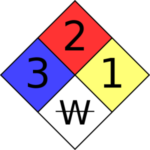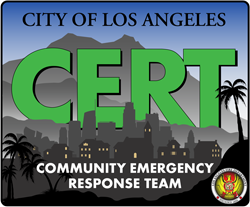CERT Flashcards
Unit 2 – Fire Safety
Avoid the “electrical octopus.” Eliminate tangles of electrical cords.
Don’t overload electrical outlets. Don’t plug power strips into other power strips.
Don’t run electrical cords under carpets.
Check for and replace broken or frayed cords immediately.
Maintain electrical appliances properly. Repair or replace malfunctioning appliances.
The Department of Transportation (DOT) placards
The United Nations (UN) system
The North American (NA) warning placards
Read labels to identify flammable products.
Store them properly, using the LIES method (Limit, Isolate, Eliminate, Separate).
You should only extinguish a flammable liquid using a portable fire extinguisher rated for Class B fires.
DON’T get too close. Stay near the outer range of your extinguisher. If you feel the heat, you are too close.
DON’T try to fight a fire alone. Remember that your first priority is your personal safety. Don’t put it at risk.
DON’T try to suppress large fires. Learn the capability of your equipment, and do not try to suppress a fire that is clearly too large for the equipment at hand (i.e., a fire that is larger than the combined ratings of available fire extinguishers).
DON’T enter smoke-filled areas. Suppressing fires in smoke-filled areas requires equipment that CERTs don’t have.
Every member of the household should be aware of the following procedures in the event of an electrical emergency:
Locate the circuit breakers or fuses, and know how to shut off the power.
Post shutoff instructions next to the breaker box or fuse box.
Unscrew individual fuses or switch off smaller breakers first, then pull the main switch or breaker.
When turning the power back on, turn on the main switch or breaker first, then screw in the fuses or switch on the smaller breakers, one at a time.
Do not enter a flooded basement or standing water to shut off the electrical supply because water conducts electricity.
Flammable liquids (e.g., oils, gasoline) and combustible liquids (e.g., charcoal lighter fluid, kerosene).
These fuels burn only at the surface because oxygen cannot penetrate the depth of the fluid. Only the vapor burns when ignited.
Corrode other materials
Explode or are easily ignited
React strongly with water
Are unstable when exposed to heat or shock
Are otherwise toxic to humans, animals, or the environment through absorption, inhalation, injection, or ingestion
If the fire is extinguished in 5 seconds and the area is safe, you should stay and overhaul the fire.Overhauling is the process of searching a fire scene for hidden fire or sparks in an effort to prevent the fire from rekindling.Remember “cool, soak, and separate.”
Ordinary combustibles such as paper, cloth, wood, rubber, and many plastics
Capacity. Standard size is 2.5 gallons.
Range. Standard range is 30-40 feet.
Pressure. Standard pressure is 110 pounds per square inch (psi).
Use extreme caution when using a water extinguisher to ensure that the water, which is under pressure, does not scatter lightweight materials and spread the fire.Energized electrical equipment (e.g., wiring, motors).
When the electricity is turned off, the fire becomes a Class A fire.
The NFPA 704 Diamond placard is found on fixed facilities where hazardous materials are used or stored.
The diamond is divided into four colored quadrants, each with a rating number inside of it, which indicates the degree of risk associated with the material.
Numbers range from 1 to 4. The higher the number the higher the risk!
Pull (Test the extinguisher after pulling the pin)
Aim
Squeeze
Sweep
To ensure that the extinguisher is working properly, test it before approaching any fire.Common characteristics of dry chemical extinguishers include:
Capacity. Approximately 10-20 seconds discharge time
Range. Standard range is 8-12 feet.
Pressure. Standard pressure is 175-250 psi.
Heat: Heat is required to elevate the temperature of a material to its ignition point
Fuel: The fuel for a fire may be a solid, liquid, or gas. The type and quantity of the fuel will determine which method should be used to extinguish the fire
Oxygen: Most fires will burn vigorously in any atmosphere of at least 20% oxygen. Without oxygen, most fuels could be heated until entirely vaporized, yet would not burn.
These three elements, called the fire triangle, create a chemical exothermic reaction, which is fire.Electrical hazards
Natural gas hazards
Flammable or combustible liquids
Are there two ways to exit the area quickly and safely if I attempt to extinguish the fire? (The first priority for you and your buddy is safety.)
Do I have the right type of extinguisher for the type of fire?
Is the extinguisher large enough for the fire?
Is the area free from other dangers, such as hazardous materials and falling debris?
If you answer “NO” to any of these questions or if you have been unable to put out the fire in 5 seconds using the extinguisher, you should:- Leave the building immediately.Shut all doors as you leave to slow the spread of the fire.You should always err on the side of safety.
DO NOT assume that, because there is no placard, no hazardous materials are present.
Treat any unknown situation as a hazardous materials incident.
Hose
Carrying handle and trigger
Pressure gauge
Cylinder
Natural gas is an asphyxiant that robs the body of oxygen
It is an explosive that can easily ignite
The job of Team Member 1 is to put out a fire with an extinguisher.
The job of Team Member 2 is to watch for hazards and ensure the safety of both team members.
CERT sizeup consists of 9 steps and should be used in any emergency situation.
1. Gather facts
2. Assess and communicate the damage.
3. Consider probabilities.
4. Assess your own situation.
5. Establish priorities.
6. Make decisions.
7. Develop a plan of action.
8. Take action.
9. Evaluate progress.
Explosives
Flammable gases and liquids
Poisons and poisonous gases
Corrosives
Nonflammable gases
Oxidizers
Radioactive materials
Combustible metals (e.g., aluminum, magnesium, titanium)

CERT members should consider these placards a “STOP SIGN.”
The ONLY action CERT members should take is to evacuate persons who are downwind, as necessary, to an uphill or upwind location.
DO NOT enter the building in an attempt to evacuate persons inside.
W – Indicates a material that shows unusual reactivity with water (i.e., should never be mixed with water or have water sprayed on it). Magnesium metal is an example.
OX – The material possesses oxidizing properties. Ammonium nitrate is an example.
ACID – The material is an acid.
ALK – The material is a base.
COR – The material is corrosive.
Radioactive symbol – The material is radioactive.
Cooking oils (e.g., vegetable oils, animal oils, fats)
Work with a buddy
Wear safety equipment (Hard hat, Protective eyewear (safety goggles), N-95 mask, Leather work and non-latex exam gloves, Long-sleeved shirt, Reflective vest, Long pants, Sturdy shoes or boots)
The CERT goal is to do the greatest good for the greatest number.
Portable fire extinguishers, interior wet standpipes, confinement and “creative resources”
Water
Dry chemical
Carbon dioxide
Specialized fire extinguishers
To aid in extinguishing fires, fires are categorized into classes based on the type of fuel that is burning

